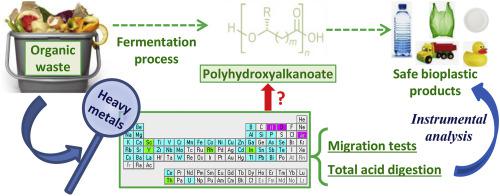Chemosphere ( IF 8.1 ) Pub Date : 2020-06-22 , DOI: 10.1016/j.chemosphere.2020.127472 Maria Luisa Astolfi 1 , Elisabetta Marconi 2 , Laura Lorini 1 , Francesco Valentino 1 , Fernando Silva 3 , Bruno Sommer Ferreira 4 , Silvia Canepari 1 , Mauro Majone 1

|
In line with the Circular Economy approach, the production of polyhydroxyalkanoate (PHA) with organic waste as the feedstock may a biotechnological application to reduce waste and recover high-value materials. The potential contaminants that could transfer from bio-waste to a PHA include inorganic elements, such as heavy metals. Hence, the total content and migratability of certain elements were evaluated in several PHA samples produced from different origins and following different methods. The total content of certain elements in PHA ranged between 0.0001 (Be) and 49,500 mg kg−1 (Na). The concentrations of some alkaline (Na and K) and alkaline earth (Ca and Mg) metals were highest, which are of little environmental concern. The feedstock type and PHA stabilisation and extraction procedures affected the element contents. Several sets of experiments were conducted to evaluate the migration of elements from the PHA samples under different storage times, temperatures, and pH levels. The total contents of some heavy metals (As, Cd, Fe, Hg, Ni, Pb, and Zn) in PHA produced from fruit waste or crops (commercial PHA) were lower than those in the PHA samples produced from the mixture of the organic fraction of municipal waste and sludge from wastewater treatment. Both the PHA obtained by extraction from wet biomass (acid storage) with aqueous phase extraction reagents and commercial PHA were below the migration limits stipulated by the current Toy Safety Directive and by Commission Regulation (EU) October 2011 on plastic materials and articles intended to come into contact with food under frozen and refrigerated conditions.
中文翻译:

源自有机废物的生物塑料中的元素浓度和迁移性。
与循环经济方法一致,以有机废物为原料生产聚羟基链烷酸酯(PHA)可能在生物技术上可以减少废物并回收高价值材料。可能从生物废物转移到PHA的潜在污染物包括无机元素,例如重金属。因此,在从不同来源和按照不同方法生产的几种PHA样品中评估了某些元素的总含量和迁移性。PHA中某些元素的总含量在0.0001(Be)和49,500 mg kg -1之间(不)某些碱金属(Na和K)和碱土金属(Ca和Mg)的浓度最高,这与环境无关。原料类型,PHA稳定和提取程序会影响元素含量。进行了几组实验,以评估PHA样品在不同的存储时间,温度和pH值下元素的迁移。从水果废物或农作物(商业PHA)中生产的PHA中某些重金属(As,Cd,Fe,Hg,Ni,Pb和Zn)的总含量低于由有机混合物制成的PHA样品中的重金属含量。废水处理产生的城市垃圾和污泥的一部分。











































 京公网安备 11010802027423号
京公网安备 11010802027423号